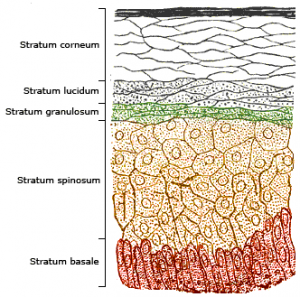What is filaggrin? Why does it matter?
Filaggrin (filament aggregating protein) plays an essential role in the organization of keratin filaments and the development of the cornified layer (stratum cornueum) of the skin, which is an essential part of the skin barrier to epidermal water loss and to the entry of microbes and noxious substances. (There are some strange aspects to filaggrin, which point to influence beyond the skin. For example, filaggrin mutations are associated with asthma.)

Figure: skin layers
Dermatitis, a.k.a. eczema is the almost normal state of the skin in which the skin feels tight, itchy, even painful at times. You will see swelling, and the lesions may eventually lead to scarring. Is filaggrin involved in dermatitis? It makes sense because eczema involves a seriously disrupted skin barrier. Also, dermatitis is particularly common on weather-exposed skin such as the cheeks and hands, and in these cases, it’s associated with filaggrin degradation. The good news is that there is also an increase in the amount of the molecules that make up the NMF, or Natural Moisturizing Factor, which helps retain moisture.
Filaggrin is essential for the regulation of epidermal homeostasis. Within the stratum corneum, filaggrin monomers can become incorporated into the lipid envelope, which is responsible for the skin barrier function. Alternatively, these proteins can interact with keratin intermediate filaments. Filaggrin undergoes further processing in the upper stratum corneum to release free amino acids that assist in water retention, the NMF.
During the winter in northern countries, the risk of dermatitis is increased due to low temperature and humidity. I assume that something of the sort happens in Summer in air conditioning environments, and also outside because of UV radiation. In any case, dermatitis is a skin affliction that is so common that we could call it normal, but it is also undesirable.
There seems to be an interplay between several elements that contribute to the integrity of the skin barrier, i.e. that decrease transepidermal water loss. Skin that is better at producing lipids (which also decrease TEWL) seems to have less filaggrin degradation.
NMF is a mix of molecules, including amino acids that help retain water. It seems to increase when the environment is drier and colder. It is likely that the components of the NMF are formed by degradation of skin proteins, including filaggrin.
The time to deal with filaggrin disruptions is before the changes that lead to the formation of corneocytes, after all, those are dead cells How and when? Increase the supply of lipids that the skin converts into ceramides and other molecules that prevent water loss. We should also work hard at preventing inflammation, a process that occurs deep within the skin, not just at the very superficial level when we see increased rugosity.
Please remember that many ingredients used in skincare can irritate the skin, dry it, or cause allergies. Don’t assume that every skincare product is good for you. You don’t need fragrances or essential oils unless the essential oil is in there for a reason.
What can you do?
As usual, avoid UV radiation (avoid the sun and wear sunblock), go for ELS serum (every lipid serum), skin-soothing serum, and/or ultra-calming cream.
Engebretsen, K. A., Kezic, S., Riethmüller, C., Franz, J., Jakasa, I., Hedengran, A., … Thyssen, J. P. (2018). Changes in filaggrin degradation products and corneocyte surface texture by season. British Journal of Dermatology, 178(5), 1143–1150. doi:10.1111/bjd.16150
Kim, Y.-J., Choi, M. J., Bak, D.-H., Lee, B. C., Ko, E. J., Ahn, G. R., … Kim, B. J. (2018). Topical administration of EGF suppresses immune response and protects skin barrier in DNCB-induced atopic dermatitis in NC/Nga mice. Scientific Reports, 8(1). doi:10.1038/s41598-018-30404-x
